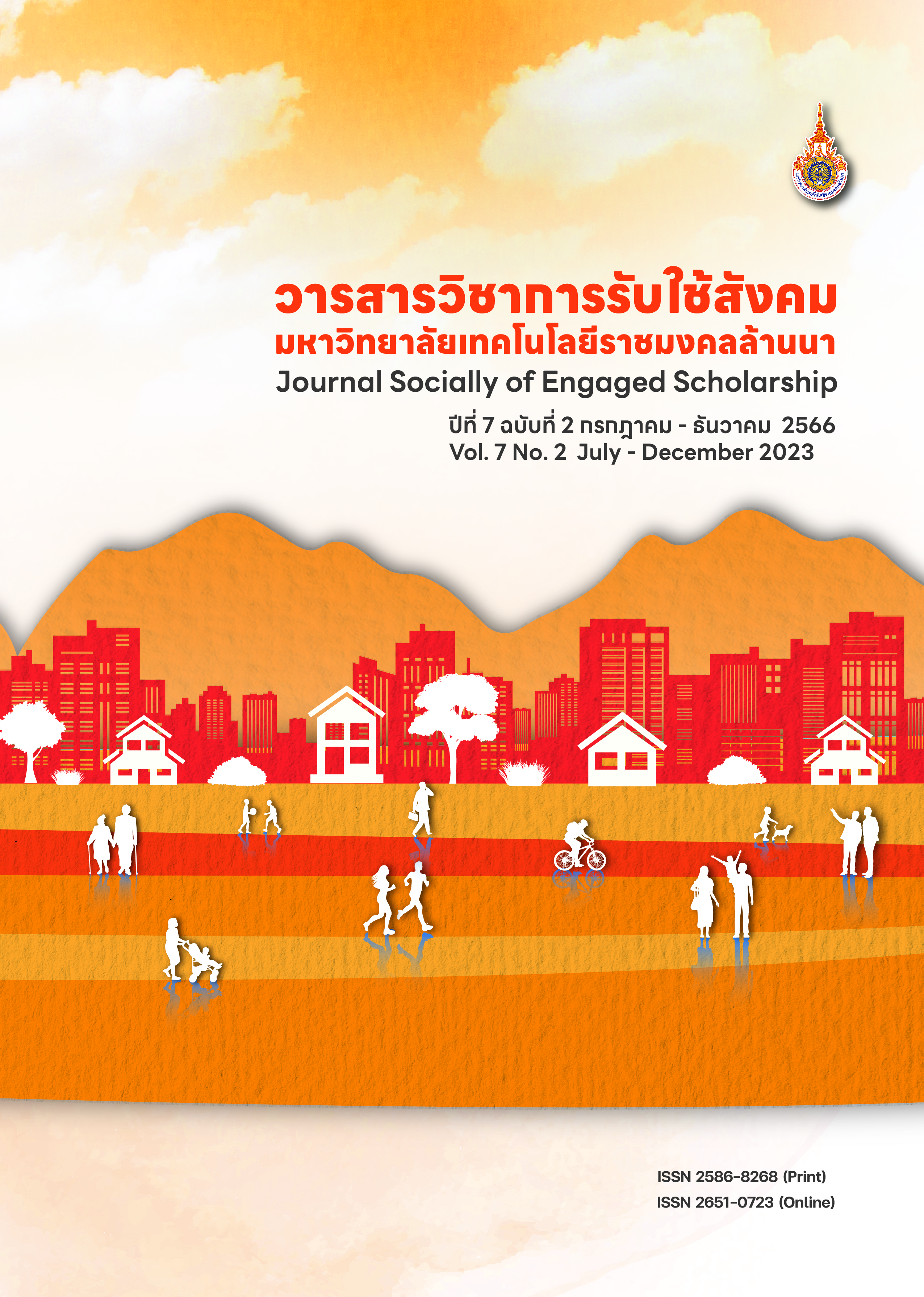แนวทางการพัฒนากลุ่มเพาะเห็ดฟาง ชุมชนบ้านช้าง ตำบลช้างใหญ่ อำเภอบางไทร จังหวัดพระนครศรีอยุธยา
Main Article Content
บทคัดย่อ
แนวทางการพัฒนากลุ่มเพาะเห็ดฟาง ชุมชนบ้านช้าง ตำบลช้างใหญ่ อำเภอบางไทร จังหวัดพระนครศรีอยุธยา มีวัตถุประสงค์เพื่อศึกษาแนวทางการพัฒนากลุ่มเพาะเห็ดฟางและการจัดตั้งกลุ่มเพาะเห็ดฟางโดยมีวิธีการดำเนินงานดังนี้ คือ 1) การศึกษาและสำรวจบริบทพื้นที่ โดยการสนทนากลุ่ม 2) การถ่ายทอดองค์ความรู้ด้วยการอบรมเชิงปฏิบัติการโดยชุมชนมีส่วนร่วม และ 3) ประเมินผลลัพธ์จากการดำเนินงาน ผลจากการศึกษาวิเคราะห์แนวทางการพัฒนาและประเมินศักยภาพบริบทพื้นที่ร่วมกันกับชุมชน ผู้วิจัย และปราชญ์ชาวบ้าน พบว่า ชุมชนมีความต้องการพัฒนาอาชีพเพาะเห็ดฟางจากเศษเหลือหลังการเก็บเกี่ยวข้าว ส่งผลให้เกิดการจัดตั้งกลุ่มเพาะเห็ดฟางบ้านช้างเป็นอาชีพเสริม ผู้วิจัยร่วมกับปราชญ์ชาวบ้านของชุมชนถ่ายทอดองค์ความรู้สู่ชุมชนตั้งแต่กระบวนการนำวัตถุดิบเศษเหลือหลังการเก็บเกี่ยวข้าว คือ ฟางข้าว มาเป็นวัตถุดิบหลักในการเพาะเห็ดฟาง โดยมีสมาชิกในกลุ่มเพิ่มขึ้นร้อยละ 84 จากสมาชิก 4 คน เป็น 25 คน ซึ่งส่งผลให้มีสถานที่โรงเรือนเพาะเห็ดฟางบ้างช้างเป็นต้นแบบของชุมชน และมีความพึงพอใจในผลการดำเนินงานร้อยละ 100 ทำให้เห็ดฟางมียอดขายเพิ่มขึ้นร้อยละ 85 ต่อเดือนจาก 3,000 บาท เป็น 20,000 บาท เป็นการเพิ่มมูลค่าผลผลิตทางการเกษตรจากเศษเหลือหลังการเก็บเกี่ยวและทางกลุ่มมีการบริหารจัดการกลุ่มได้เอง เกิดการกระจายรายได้สู่ตลาดชุมชน สร้างงานสร้างรายได้ให้กับชุมชน
Article Details
บทความนี้ได้รับการเผยแพร่ภายใต้สัญญาอนุญาต Creative Commons Attribution-NonCommercial-NoDerivatives 4.0 International (CC BY-NC-ND 4.0) ซึ่งอนุญาตให้ผู้อื่นสามารถแชร์บทความได้โดยให้เครดิตผู้เขียนและห้ามนำไปใช้เพื่อการค้าหรือดัดแปลง หากต้องการใช้งานซ้ำในลักษณะอื่น ๆ หรือการเผยแพร่ซ้ำ จำเป็นต้องได้รับอนุญาตจากวารสาร
เอกสารอ้างอิง
กระทรวงการอุดมศึกษา วิทยาศาสตร์ วิจัย และนวัตกรรม. 2564. โครงการขับเคลื่อน เศรษฐกิจด้วยเศรษฐกิจ BCG Economy.สืบค้นเมื่อวันที่ 30 เมษายน 2564 จาก: https://www.mhesi.go.th/index.php/pr- executive-news/5339-bcg-7-covid-19.html
กิตติพงษ์ กีรติเตชะนันท์. 2563. My Little Farm Vol. 10 ปลูกเห็ดแบบคนเมือง/Mushroom Man. (พิมพ์ครั้งที่ 1). กรุงเทพฯ:บ้านและสวน อมรินทร์พริ้นติ้ง แอนด์ พับลิชชิ่ง.
เจนจิรา นามี, ปณัท สุขสร้อย, ฉัตรเกษม ดาศรี และ เพ็ญศรี ชิตบุตร. 2564. “การใช้ประโยชน์จากฟางข้าวเพื่อการเพาะเห็ดนางฟ้า ตำบลโนนหมากมุ่น จังหวัดสระแก้ว”. วารสารวิจัยเพื่อการพัฒนาเชิงพื้นที่. 13, 3: 163-179.
ณัฐพล ใยไพโรจน์. 2561. Digital Marketing 5G : Concept & Case study. (พิมพ์ครั้งที่ 1). นนทบุรี:ไอดีซีฯ.
เทศบาลตำบลราชคราม. 2565. ข้อมูลทั่วไป ตำบลช้างใหญ่. สืบค้นเมื่อวันที่ 15 เมษายน 2565จาก: https://ratchakhram.go.th/public/
ธันวมาส กาศสนุก, คงเดช พะสีนาม และอรพิน เสละคร. 2565. “ผลของการใช้วัสดุเพาะที่แตกต่างกันต่อการผลิตเห็ดฟางในตะกร้าพลาสติก”. วารสารวิทยาศาสตร์เทคโนโลยีและนวัตกรรม มหาวิทยาลัยกาฬสินธุ์. 1, 1: 11-18.
สามารถ ใจเตี้ย. 2563. “การใช้ประโยชน์วัสดุเหลือใช้ทางการเกษตรของเกษตรกรในเทศบาลตำบลขี้เหล็ก อำเภอแม่ริม จังหวัดเชียงใหม่”. วารสารวิจัยและส่งเสริมวิชาการเกษตร. 38, 2: 79-88.
สำนักงานสภาพัฒนาการเศรษฐกิจและสังคมแห่งชาติ สำนักนายกรัฐมนตรี. 2566. แผนแม่บทภายใต้ยุทธศาสตร์ชาติ (พ.ศ. 2566 - 2580) ( แก้ไขเพิ่มเติม). สืบค้นเมื่อวันที่ 9 พฤษภาคม 2566 จาก: http://nscr.nesdc.go.th/master-plans/
อภิชาติ ศรีสะอาด และ พัชรี สำโรงเย็น. 2560. เห็ดฟางคนเมือง & เพื่อการค้า 5 ภาค. (พิมพ์ครั้งที่ 1). กรุงเทพฯ:นาคา อินเตอร์มีเดีย.
อรชลลดา ทับทิมดี, ทรงวุฒิ เอกวุฒิวงศา และพิชัย สดภิบาล. 2560. “ศึกษาและพัฒนากระบวนการใช้ประโยชน์จากเศษวัสดุตอซังข้าว สำหรับการออกแบบ ผลิตภัณฑ์เพื่อสิ่งแวดล้อม”.วารสารวิชาการศิลปะสถาป้ตยกรรมศาสตร์มหาวิทยาลัยนเรศวร. 10, 2: 127-139.


